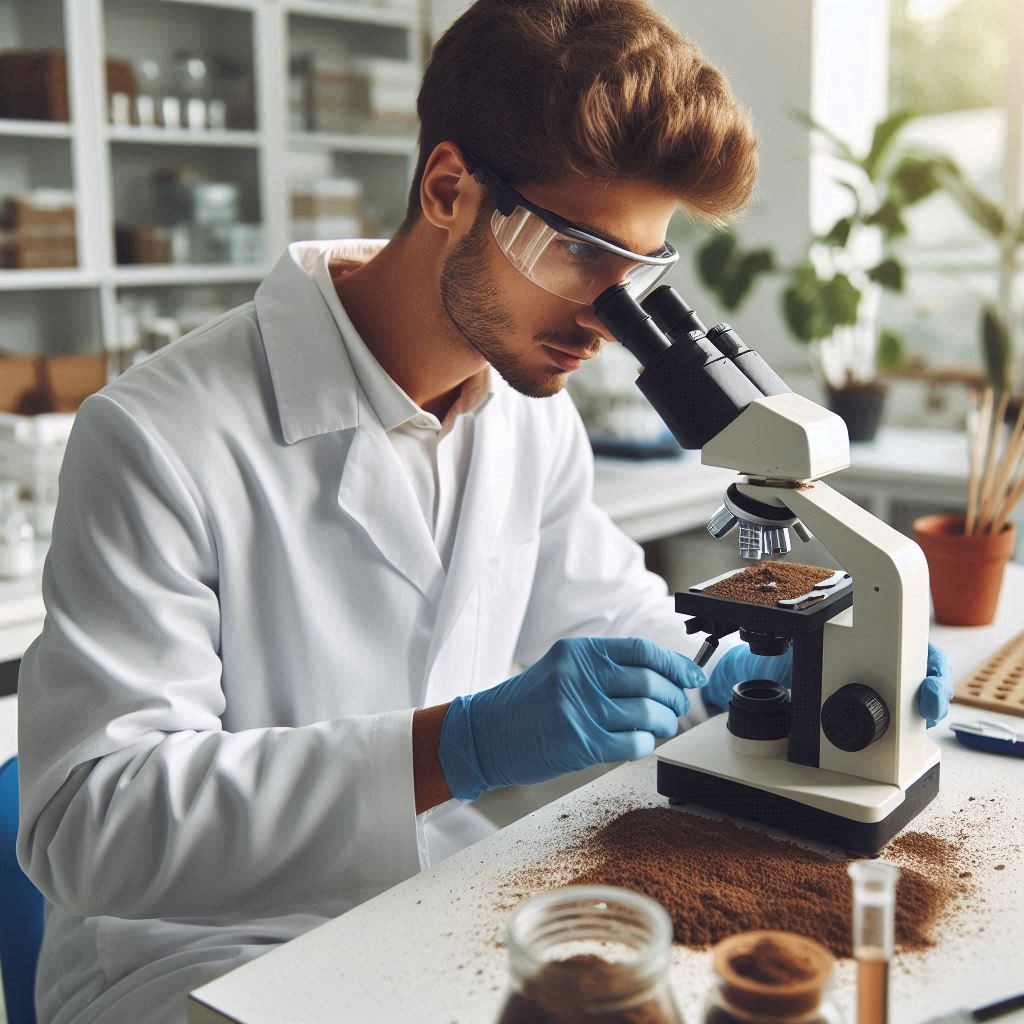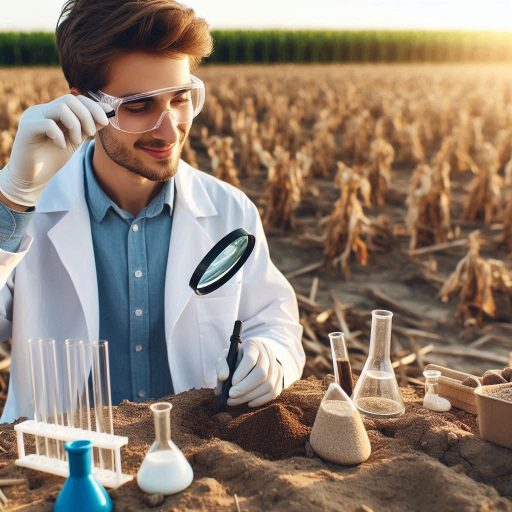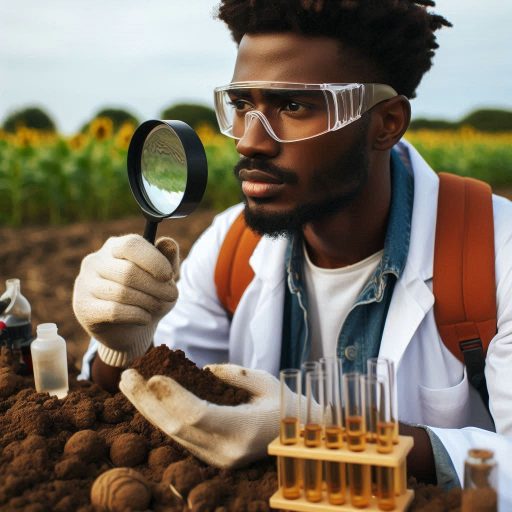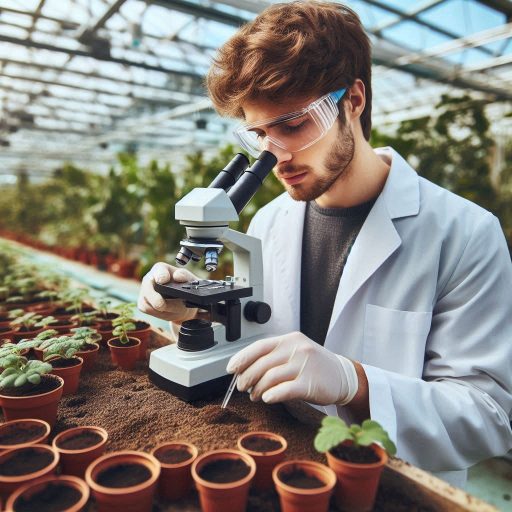Introduction
The intersection of soil science and biotechnology represents a rapidly evolving field with significant implications.
Soil scientists study soil health, fertility, and structure, while biotechnologists focus on genetic engineering and molecular biology.
Combining these disciplines enhances our understanding of soil ecosystems and improves agricultural practices.
This intersection is important because it addresses critical global challenges.
Sustainable agriculture relies on healthy soils, which are essential for food production and environmental health.
Biotechnological innovations, such as genetically modified organisms (GMOs) and biofertilizers, can enhance soil health and increase crop yields.
Additionally, biotechnology offers tools for soil remediation, helping to restore contaminated lands and improve soil quality.
Understanding the synergy between soil science and biotechnology is crucial for developing sustainable solutions that benefit both farmers and the environment.
In this blog post, we will explore key innovations at this intersection.
We will discuss the role of microbial biotechnology in enhancing soil health and fertility.
We will also cover advances in soil genomics and how they inform sustainable agricultural practices.
By examining these topics, we aim to highlight the importance of integrating soil science and biotechnology.
This integration can lead to more resilient agricultural systems and better environmental outcomes.
Understanding Soil Science
Importance of Soil in Agriculture and the Environment
Healthy soil is essential for productive agriculture.
It provides nutrients, water, and support for plants.
Without soil, we would struggle to grow crops and sustain livestock.
Agricultural practices directly impact soil health, influencing food quality and yield.
Soil also plays a significant role in environmental health.
It filters water, removing pollutants and improving water quality.
Healthy soils mitigate flooding by absorbing excess rainwater.
They also store carbon, helping combat climate change and reduce greenhouse gas emissions.
Furthermore, soil supports biodiversity.
A variety of organisms thrive in healthy soils, contributing to ecosystem functions.
Microorganisms decompose organic matter, releasing nutrients back into the soil.
This process sustains plant growth and supports food webs.
Key Concepts and Principles of Soil Science
Soil science encompasses several key concepts and principles.
Understanding soil composition is crucial, as it includes minerals, organic matter, water, and air.
The balance of these components affects soil health and fertility.
Soil structure refers to the arrangement of soil particles.
Good soil structure improves water infiltration and root penetration.
Soil texture, determined by particle size, influences drainage and nutrient retention.
Sandy soils drain quickly, while clayey soils hold water and nutrients.
Soil pH is another important factor.
It affects nutrient availability and microbial activity.
Most crops thrive in slightly acidic to neutral soils.
Soil scientists often conduct tests to determine pH levels and recommend adjustments if necessary.
Understanding soil horizons is also crucial.
Soil develops in layers, or horizons, each with distinct characteristics.
The top layer, rich in organic matter, supports plant life.
Deeper layers store nutrients and water, influencing root growth.
Role of Soil in Sustaining Life on Earth
Soil sustains life on Earth in multiple ways.
It serves as a habitat for countless organisms, from bacteria to earthworms.
These organisms contribute to nutrient cycling, improving soil fertility.
Plants depend on soil for growth.
They extract water and nutrients through their roots.
Healthy soil promotes robust plant growth, providing food for animals and humans alike.
Soil also plays a critical role in the water cycle.
It stores and filters water, replenishing aquifers and surface water sources.
This process ensures a steady supply of freshwater for ecosystems and human use.
Moreover, soil acts as a natural filter for contaminants.
It captures and breaks down harmful substances, protecting our waterways and ecosystems.
Healthy soils enhance resilience against environmental stressors, such as climate change and pollution.
The intersection of soil science and biotechnology is essential for sustainable agriculture and environmental health.
Understanding the importance of soil in agriculture and the environment, along with key concepts of soil science, highlights its critical role in sustaining life on Earth.
By prioritizing soil health, we can ensure a sustainable future for our planet and its inhabitants.
Embracing the principles of soil science allows us to harness biotechnology to enhance soil quality and productivity while protecting our environment.
Read: Exploring the Different Branches of Geology
The Role of Biotechnology in Agriculture
Defining Biotechnology and Its Applications in Agriculture
Biotechnology involves using living organisms to develop or enhance products.
In agriculture, it applies to breeding, genetic modification, and crop management.
Through biotechnology, scientists manipulate genetic material to improve plants’ traits, such as disease resistance and yield.
One common application of biotechnology in agriculture is genetically modified organisms (GMOs).
These organisms undergo genetic alterations to exhibit desired characteristics.
For instance, scientists can insert genes that confer resistance to pests or environmental stress.
Biotechnology also includes tissue culture techniques.
This method enables the rapid propagation of disease-free plants.
It allows farmers to produce large quantities of uniform plants quickly.
These techniques enhance the efficiency of crop production and contribute to food security.
How Biotechnology Has Revolutionized the Agricultural Industry
Biotechnology has revolutionized the agricultural industry by increasing productivity and sustainability.
Farmers can now grow crops that require fewer resources, such as water and fertilizers.
This efficiency reduces environmental impact and conserves vital natural resources.
One significant impact of biotechnology is pest management.
Biotech crops often incorporate traits that deter pests, reducing the need for chemical pesticides.
This shift leads to safer food production and less harm to beneficial insects.
Additionally, biotechnology has enhanced crop resilience to climate change.
Scientists develop crops that can withstand drought, floods, and extreme temperatures.
These advancements help farmers adapt to changing climate conditions and maintain stable yields.
Furthermore, biotechnology plays a role in improving soil health.
Certain biotech crops enhance soil microbial activity, promoting nutrient cycling.
Healthy soil supports plant growth and contributes to sustainable farming practices.
Examples of Biotechnological Advancements in Agriculture
Several biotechnological advancements demonstrate the power of this field in agriculture.
One example is Bt cotton, which incorporates a gene from the bacterium Bacillus thuringiensis.
This gene produces a protein toxic to specific pests, reducing the need for chemical insecticides.
Another advancement is herbicide-resistant crops, such as Roundup Ready soybeans.
These crops allow farmers to apply herbicides without harming the plants.
This technology simplifies weed management and promotes sustainable farming practices.
Genome editing techniques, like CRISPR-Cas9, represent a cutting-edge biotechnological advancement.
Researchers can use this method to make precise genetic changes in plants.
This technique holds great promise for developing crops with improved traits quickly and efficiently.
Additionally, advancements in biofortification enhance the nutritional content of crops.
For example, scientists have developed golden rice, enriched with vitamin A.
This innovation addresses micronutrient deficiencies in populations reliant on rice as a staple food.
The intersection of soil science and biotechnology offers exciting opportunities for sustainable agriculture.
Biotechnology’s applications in agriculture have transformed farming practices, increasing productivity and resilience.
Examples of biotechnological advancements illustrate the potential of this field.
By continuing to explore this intersection, researchers can develop innovative solutions for global food security and environmental sustainability.
Read: Top Skills Needed for a Successful Geology Career
Applications of Biotechnology in Soil Science
Biotechnology for Improving Soil Health and Fertility
Biotechnology offers innovative solutions to enhance soil health and fertility.
Microbial inoculants, for example, introduce beneficial microorganisms into the soil.
These microbes improve nutrient availability, leading to healthier plants.
Biofertilizers are another biotechnological advancement that boosts soil fertility.
They contain living microorganisms that facilitate nutrient uptake by plants.
By enriching the soil with these natural inputs, farmers can reduce reliance on chemical fertilizers.
Additionally, biotechnology enhances the development of genetically modified (GM) crops.
These crops can thrive in nutrient-poor soils, reducing the need for fertilizers.
GM crops can also exhibit traits like drought resistance, promoting sustainable farming practices.
Moreover, bioremediation employs microorganisms to degrade pollutants in the soil.
This method effectively restores contaminated soils, enhancing overall health.
By utilizing these biotechnological techniques, farmers can maintain productivity while protecting the environment.
Addressing Soil Degradation and Pollution
Soil degradation is a significant global challenge that threatens agricultural productivity.
Biotechnology offers various methods to address this issue effectively.
One approach involves using soil amendments enriched with beneficial microbes.
These amendments help restore soil structure and function, promoting nutrient cycling.
They can also improve soil’s ability to retain water, essential for crop growth.
By enhancing soil health, biotechnology mitigates the impacts of degradation.
Biotechnological methods also play a crucial role in reducing soil pollution.
Certain microorganisms can degrade harmful chemicals and heavy metals in contaminated soils.
By introducing these microbes, farmers can rehabilitate polluted land, making it suitable for agriculture again.
Additionally, sustainable agricultural practices supported by biotechnology help prevent further soil degradation.
By promoting cover cropping and reduced tillage, farmers protect the soil from erosion and nutrient loss.
These practices, combined with biotechnological innovations, create a resilient agricultural system.
Potential Benefits of Applying Biotechnology in Soil Science
The potential benefits of applying biotechnology in soil science are vast.
Improved soil health directly leads to increased agricultural productivity.
Healthier soils support better crop yields, ultimately enhancing food security.
Biotechnology also promotes environmental sustainability.
By reducing chemical inputs, it minimizes the ecological footprint of agriculture.
This shift towards sustainable practices fosters biodiversity in soil ecosystems.
Furthermore, biotechnology contributes to climate change mitigation.
Healthy soils can sequester carbon, helping to reduce greenhouse gas emissions.
By implementing biotechnological methods, farmers can play a vital role in combating climate change.
Lastly, biotechnology enhances the resilience of agricultural systems.
Crops that withstand stressors like drought and disease lead to more stable food supplies.
As global populations grow, these innovations become increasingly important for ensuring food security.
The intersection of soil science and biotechnology holds great promise for the future of agriculture.
By improving soil health and fertility, biotechnology addresses critical challenges like soil degradation and pollution.
The potential benefits of these methods contribute to sustainable farming practices and enhanced food security.
Embracing biotechnology in soil science can lead to a healthier planet and a more resilient agricultural system, benefiting both farmers and the environment.
Read: The Future of Botany: Emerging Fields and Innovations

Challenges and Limitations
Challenges and Limitations of Applying Biotechnology in Soil Science
One major challenge in applying biotechnology to soil science is the complexity of soil ecosystems.
Soil contains diverse microorganisms, fungi, and organic matter that interact in intricate ways.
Introducing biotechnological interventions may disrupt these delicate relationships.
Another limitation is the uncertainty surrounding the long-term effects of biotechnological products.
For example, genetically modified organisms (GMOs) can alter soil microbiomes in unpredictable ways.
Researchers often lack sufficient data to assess these changes thoroughly.
Additionally, regulatory hurdles pose significant challenges.
The approval process for biotechnological products can be lengthy and complex.
Navigating these regulations may delay research and implementation, hindering progress in the field.
Economic factors also play a crucial role.
Farmers may hesitate to adopt biotechnological solutions due to high costs or lack of financial support.
This reluctance can slow the widespread adoption of beneficial biotechnological practices.
Ethical Considerations and Potential Risks
Ethical considerations surrounding biotechnology in soil science are vital.
One major concern is the potential for ecological harm.
Biotechnological interventions may lead to unintended consequences, such as loss of biodiversity or soil degradation.
Another ethical issue involves the use of GMOs.
Critics argue that modifying organisms raises questions about food safety and environmental impact.
Public perception plays a significant role in shaping policies related to biotechnology.
Moreover, there are concerns about equity in access to biotechnological advancements.
Farmers in developing countries may lack access to the resources needed for biotechnology implementation.
This disparity can widen the gap between affluent and disadvantaged farmers.
Addressing and Overcoming Challenges
To overcome the challenges associated with biotechnology in soil science, collaboration is essential.
Scientists, farmers, and policymakers must work together to share knowledge and resources.
This collaboration can facilitate research on sustainable biotechnological practices.
Conducting long-term studies is crucial for assessing the impacts of biotechnology on soil health.
Researchers should focus on monitoring soil ecosystems after introducing biotechnological products.
These studies can provide valuable insights and help refine biotechnological approaches.
Establishing clear regulatory frameworks is also necessary.
Policymakers should create guidelines that promote safe and responsible use of biotechnology.
These frameworks should prioritize transparency and public engagement to build trust.
Education plays a vital role in addressing ethical concerns.
Providing information about biotechnology and its benefits can help alleviate public fears.
Engaging with communities and stakeholders fosters dialogue and encourages informed decision-making.
Finally, supporting economic initiatives can encourage farmers to adopt biotechnological solutions.
Governments and organizations can provide financial incentives for sustainable practices.
This support can help reduce the barriers to entry for farmers interested in biotechnology.
In essence, the intersection of soil science and biotechnology presents both challenges and opportunities.
Identifying limitations, addressing ethical considerations, and implementing solutions is crucial for progress.
By fostering collaboration, conducting research, and establishing clear regulations, the field can advance responsibly.
Ultimately, addressing these challenges will enhance the potential of biotechnology to improve soil health and promote sustainable agriculture.
Read: What Does a Geologist Do? Career Overview and Insights
Learn More: Prominent Soil Science Laboratories in the USA
Current Trends and Innovations
Latest Trends and Innovations
Recent trends in soil science and biotechnology focus on sustainable practices and enhancing soil health.
Researchers are developing biotechnological solutions that improve soil microbiomes.
These innovations aim to increase nutrient availability and support plant growth without relying heavily on chemical fertilizers.
One notable trend involves using microbial inoculants to enhance soil fertility.
These beneficial microorganisms promote plant health by improving nutrient uptake and suppressing soil-borne diseases.
Biopesticides derived from natural sources also gain traction, offering eco-friendly alternatives to traditional pesticides.
Another trend is the application of precision agriculture.
Advanced technologies, such as drones and remote sensing, help monitor soil conditions.
By analyzing soil health data, farmers can make informed decisions about crop management and resource allocation.
Recent Research Developments and Breakthroughs
Recent research developments highlight the potential of biotechnology in improving soil health.
Studies show that specific microbial communities can significantly enhance soil structure and fertility.
These breakthroughs demonstrate that managing soil microbiomes can lead to sustainable agricultural practices.
Researchers are also exploring genetic engineering to enhance crops’ resilience to environmental stress.
This approach focuses on developing plants that can thrive in degraded or nutrient-poor soils.
Such innovations could revolutionize agriculture, especially in areas facing soil degradation and climate challenges.
Furthermore, studies reveal the role of soil organic matter in carbon sequestration.
Understanding how to enhance organic matter content in soils can help mitigate climate change.
Innovative biotechnological practices are emerging to increase soil carbon storage, benefiting both agriculture and the environment.
Transform Your Career Today
Unlock a personalized career strategy that drives real results. Get tailored advice and a roadmap designed just for you.
Start NowKey Players and Organizations Driving Advancements
Several key players and organizations are at the forefront of advancements in soil science and biotechnology.
Academic institutions play a critical role in research and innovation.
Universities often collaborate with industry partners to develop practical applications for their findings.
Private companies also contribute significantly to this field.
Biotech firms focus on developing microbial products and biopesticides that promote soil health.
These companies often partner with agricultural producers to implement their innovations in real-world farming scenarios.
Non-profit organizations advocate for sustainable practices in soil management.
They conduct research, provide educational resources, and promote policies that support soil health.
Collaborations between these organizations and research institutions foster advancements in soil science and biotechnology.
Moreover, international organizations, such as the Food and Agriculture Organization (FAO), promote sustainable agricultural practices.
They support research initiatives and provide guidelines to enhance soil management worldwide.
Their efforts help ensure food security and environmental sustainability.
The intersection of soil science and biotechnology presents exciting opportunities for advancing sustainable agriculture.
Recent trends emphasize the importance of microbial management, precision agriculture, and genetic engineering.
Ongoing research developments highlight the potential for improving soil health and mitigating climate change.
Key players, including academic institutions, private companies, and non-profit organizations, drive these advancements.
By fostering collaboration and innovation, we can enhance soil health and promote sustainable practices that benefit agriculture and the environment.
Future Prospects and Opportunities
Potential Impact of Advancements in Soil Science and Biotechnology
Advancements in soil science and biotechnology can revolutionize our understanding of soil health and fertility.
Improved techniques for analyzing soil microbiomes can uncover valuable insights into soil ecosystems.
By identifying beneficial microorganisms, researchers can develop biofertilizers that enhance plant growth while reducing chemical inputs.
Furthermore, genetic engineering can play a significant role in developing crops that thrive in diverse soil conditions.
Researchers can engineer plants to better absorb nutrients and tolerate stress from drought or salinity.
These innovations can improve crop yields and promote resilience in agriculture.
Additionally, advancements in soil remediation techniques can lead to healthier ecosystems.
Bioremediation utilizes microorganisms to clean up contaminated soils.
Enhanced methods can expedite the breakdown of pollutants, restoring soil health and function.
Opportunities for Collaboration and Interdisciplinary Research
The intersection of soil science and biotechnology presents numerous opportunities for collaboration.
Researchers from both fields can work together to develop innovative solutions.
Interdisciplinary teams can tackle complex challenges such as soil degradation and climate change impacts.
Academic institutions, government agencies, and private companies can collaborate on research projects.
These partnerships can facilitate the sharing of knowledge, resources, and expertise.
Joint efforts can lead to the development of new technologies that enhance soil management and agricultural practices.
Conferences and workshops can also foster collaboration.
By bringing together experts from various disciplines, these events encourage knowledge exchange and idea generation.
Collaborative research initiatives can lead to breakthroughs that benefit both soil science and biotechnology.
Contributions to Sustainable Agriculture and Environmental Conservation
The integration of soil science and biotechnology can significantly contribute to sustainable agriculture.
By optimizing soil health through biotechnological advancements, farmers can increase crop productivity.
Healthier soils lead to enhanced nutrient cycling, promoting sustainable farming practices.
Moreover, biotechnology can help develop crops that require fewer chemical inputs.
By engineering plants to resist pests and diseases, farmers can reduce pesticide usage.
This reduction decreases environmental impact and enhances soil health.
In addition, the intersection of these fields can support environmental conservation efforts.
Sustainable land management practices can be developed to restore degraded soils.
Implementing biotechnology in restoration projects can enhance the resilience of ecosystems.
Research in this area can also lead to better understanding of soil carbon sequestration.
Enhanced soil health practices can improve carbon storage, mitigating climate change effects.
The dual benefits of agricultural productivity and environmental protection make this integration crucial.
The intersection of soil science and biotechnology presents exciting opportunities for innovation and collaboration.
Advancements in these fields can significantly impact sustainable agriculture and environmental conservation.
By working together, researchers can develop solutions that improve soil health, enhance crop productivity, and promote sustainability.
As we explore this intersection, we pave the way for a more resilient and sustainable future for agriculture and the environment.
Find Out More: Education Path for Marine Biologists
Conclusion
The intersection of soil science and biotechnology holds great potential for advancing agriculture and environmental sustainability.
This blog highlighted key points about how these fields complement each other.
Soil scientists study soil properties, while biotechnologists apply innovative techniques to improve crops and soil health.
Biotechnology enhances soil management by developing biofertilizers and biopesticides.
These products promote plant growth and protect against pests without harming the environment.
Additionally, genetically modified organisms (GMOs) can be engineered to thrive in various soil conditions, increasing crop resilience and yields.
The blog emphasized that understanding soil biology is crucial for successful biotechnological applications.
Healthy soil ecosystems support beneficial microbes that enhance nutrient availability and promote plant health.
Collaborating across disciplines allows for a more comprehensive approach to soil management.
Researchers and practitioners should explore the dynamic and promising intersection of soil science and biotechnology.
Continued innovation in this area can lead to sustainable agricultural practices and improved food security.
Engaging in interdisciplinary research projects can foster new insights and solutions.
Attending conferences and workshops can facilitate collaboration and knowledge sharing.
By investing time in this field, you can contribute to a more sustainable future for agriculture and the environment.




